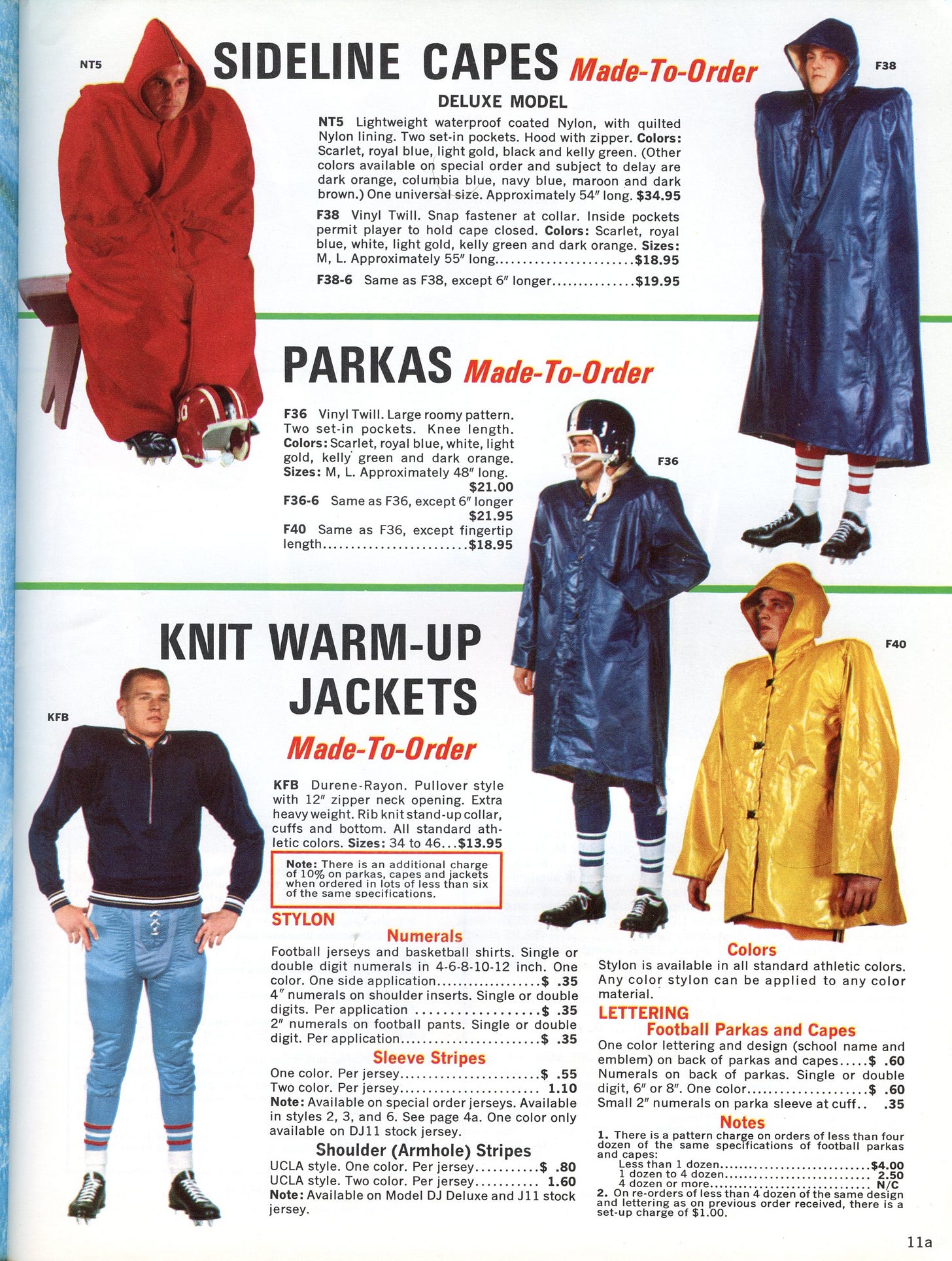The 1964 MacGregor Catalog - Helmets and Sideline Gear
Having previously reviewed the jerseys, pants, and padding for the legs offered by MacGregor in 1964, we turn to helmets and sideline gear. The MacGregor helmets of the era appear to include some cutting-edge elements and others that seem behind the times. For example, the Cy-Co-LITE vinyl helmet shells still protrude around the ears, a form that arose in the leather helmet era and carried over when they moved to plastic. Their top-of-the-line helmets cushioned the head in all directions with padding of different materials. They also sold suspension helmets that cost about the same as the cushioned helmets but ensured you received every concussion possible.
The catalog page below has two interesting elements. One is the HC5 Head Cushion, and the other is the HBC Back Head Cushion. I previously wrote about the research MacGregor funded that led to Absorblo exterior helmet pads. The exterior pads gained a following in the early 1960s that quickly disappeared. It is unclear whether MacGregor gave up on the Absorblo product or chose not to use the brand name in the catalog description for some reason.
The other item of note is the HBC Back Head Cushion. I don’t recall seeing one of these before, and assume it performed a role comparable to nose bumper rather than a neck roll. We covered nose bumpers briefly in an article about a 1955 Spalding catalog.
The catalog page featuring face masks and mouth guards shows a handful of period face masks, with several being immediately recognizable. The 14NG is the large scooping face mask that seemed to have been attached to every NFL lineman’s helmet for about a decade. Then they realized it extended too far from the helmet, producing excess leverage when an opponent’s hand thrust up into the face mask from below.
Other elements from the page above were the mouth guards, none of which were custom-molded. My favorite version is the MTP, which represents the solution to a problem that soon disappeared. A Tidbit from June 2022 shows an MTP Mill-Mont Teeth Protector or a rival product in use in the wild. The MTP helped players keep track of their mouth guards by attaching them to the chin strap, but as face masks came into nearly universal use in the 1960s, mouth guards were soon strapped to face masks rather than chin straps.
Finally, MacGregor made sideline capes and parkas available to teams playing north of the Mason-Dixon line. They also sold pullover warm-up jackets, which, like the MTP, were on their last legs or arms. Warm-up jackets were more common in football’s single-platoon days, when players warmed up and then sat on the bench for the next several hours, but the college rules of 1964 eliminated the last vestige of single-platoon substitution rules, so the warm-up jackets were no longer hot items.
Lawsuits and broad concern about football safety led to the formation of the National Operating Committee on Standards for Athletic Equipment (NOCSAE) in 1970. At the time, there were 23 helmet manufacturers, but many left the business as NOCSAE’s testing showed many helmet models were not up to the task, and significant R&D expenditures were needed to meet the new standards. The end for MacGregor helmets came in 1974; by 1983, only three manufacturers remained in the helmet-making business. MacGregor, which was one of the nation’s first golf equipment manufacturers, lives on in the golf world today.
Football Archaeology is reader-supported. Click here to buy one of my books or otherwise support the site.







Absorblo by McGregor. Marketing Department innovation back then, sure cause for pink slip now.
Also enjoyed the mouthpiece background. Didn’t see the ultimate bait and switch mouthpiece from the 70s, though…the Mint-Flavored Mouthpiece, which lost its mint flavor by the time you got to the car in the sporting goods store parking lot.
I was not aware of the mint-flavored mouthpiece. I thought they are required to taste like moldy saliva with dirt essence.